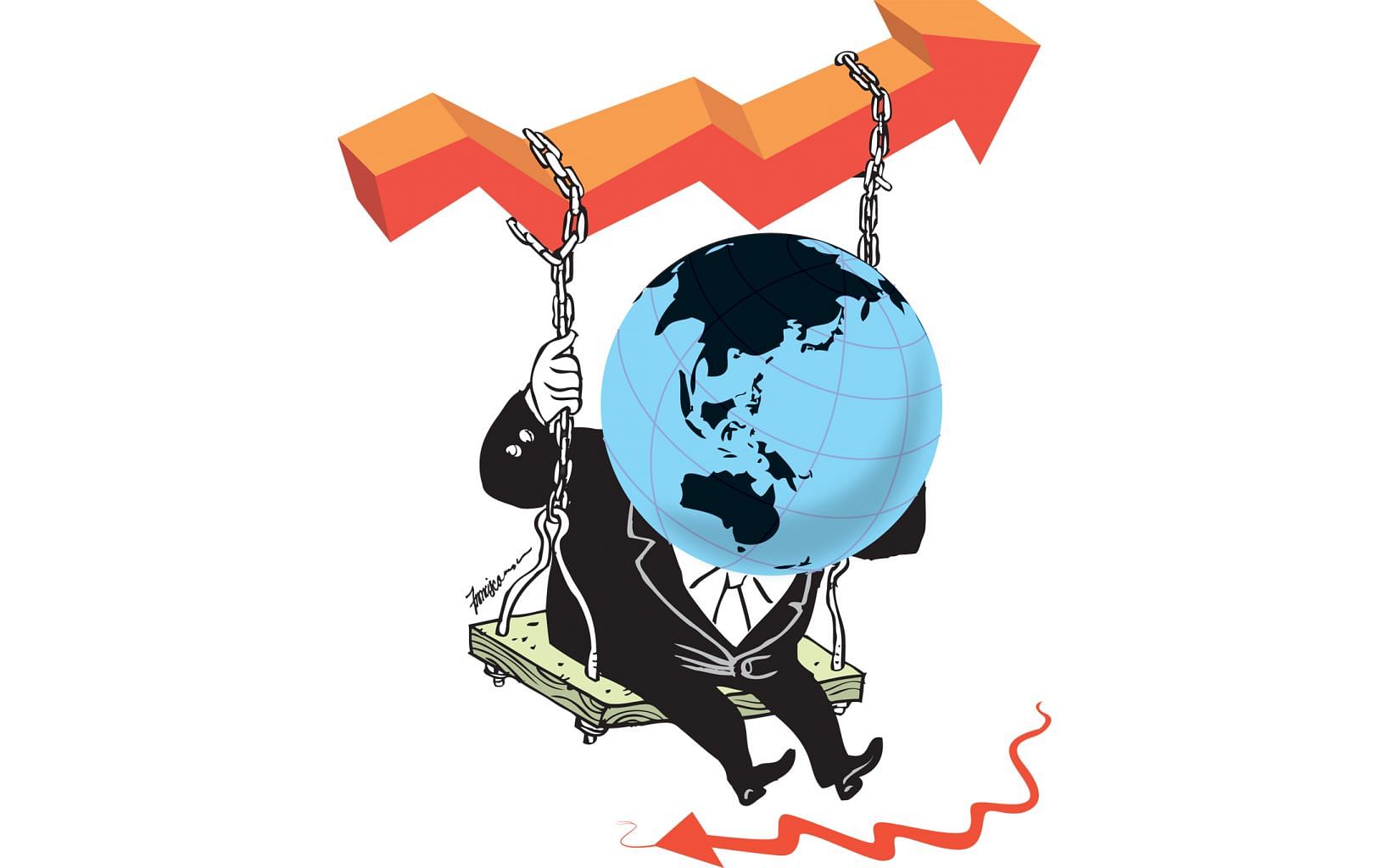On the surface, the global stock market looks serene, even buoyant.
The current bull run on widely-watched market barometers such as the Dow Jones Industrial Average and S&P 500 is already the second longest on record since market data was tracked in the past 100 years.
This has propelled stock valuations in markets such as that in the United States to levels which are much higher than in October 1987, when Wall Street plummeted 23 per cent in one day in what was known as the Black Monday crash.
What's more, the Vix Index on Wall Street, which tracks the volatility of stocks in the S&P 500, has sunk to around 11 points, or just above its lowest level on record, while its counterpart, the Vstoxx, which provides a similar measure of volatility for euro-zone blue chips, is also trending at near record-low levels.
But despite the surface calm, doubts assail investors over the sustainability of the current buoyant stock market conditions, especially as the 10th anniversary of the global financial crisis comes and goes, sparking much reflection on that event.
In 2007, a crisis in US sub-prime mortgages spiralled into a major financial shock. US financial institutions were giving out loans to people with no jobs, no assets, no incomes. This fuelled a housing boom. These dud loans were then repackaged as triple-A-rated bonds before being sold to financial institutions around the world, thus poisoning their balance sheets.
Things came to a head in early 2007 when sub-prime borrowers defaulted on their loans in huge numbers, turning these so-called triple-A-rated bonds into worthless paper. As awkward questions were asked about how badly these lenders had been infected by the sub-prime virus, it caused the interbank lending market to freeze up as banks became too scared to lend to one another.

This, in turn, caused the costs of funding to escalate, pushing the global economy into recession as mortgage defaults multiplied and many banks in the US and Europe started to fail.
In Singapore, economic growth slipped from 9.1 per cent in 2007 to 1.8 per cent in 2008. It then contracted 0.6 per cent in 2009 before recovering strongly in 2010 with 15.2 per cent growth.
The crisis was finally doused as the US Federal Reserve and other major central banks flooded the world's banking system with tonnes of fresh money with massive purchases of bonds and other securities in a bid to drive down borrowing costs.
Some analysts are asking today if the current calm is just the lull before another storm.
WORRYING SIGNS
Some analysts are worried.
The latest monthly survey conducted by US investment bank Bank of America Merrill Lynch issued on Aug 16canvassed 174 fund managers for their views on the market outlook. A record high 46 per cent of the respondents believed that equity markets are overvalued and only one-third of them believed that corporate profit - the gauge of a company's financial health - will improve in the next 12 months.
Even the bond market looks expensive. Years of extremely low interest rates have made investors hungry for returns of any kind and this has caused them to snap up high-yield corporate bonds which previously appealed only to those with a big risk appetite.
One example: In Singapore, demand has surged for perpetuals, a bond-like instrument offering an attractive interest payout but coming with a catch that the bond issuer has the discretion to withhold interest payment without fears of being sued for bankruptcy or defaulting on its other loan obligations.
Years ago when perpetuals first made their appearance here, only the bluest of the blue chips - the three local lenders - were able to issue them because their ability to make the interest payments was never in doubt. But now, other companies are finding it a breeze to sell them as well. This year so far, the issuers have included Sembcorp Industries which sold $200 million perpetuals, and Wing Tai Holdings which issued $150 million perpetuals.
What's more, investors were so desperate that Sembcorp and Wing Tai had been able to fix interest rates of 3.7 per cent and 4.08 per cent respectively on their perpetuals. This is roughly the same as the 4 per cent interest which a Central Provident Fund (CPF) holder gets on his CPF Special Account, even though the risks of holding perpetuals are much higher.
But the biggest worry of all must be the wild enthusiasm with which some investors have been chasing after cryptocurrencies such as bitcoin, which had quadrupled in price to more than US$4,627 in the past eight months. If there is a bubble waiting to burst, I would place my wager on cryptocurrencies, as this digital form of money has no intrinsic value whatsoever and no government backing.
It leads to a big question - are asset prices justified at their current elevated levels? And if so, will the bubble, when it pops, take the world down with it ?
NO CRISIS, BUT RISKS REMAIN
Dr Shane Oliver, head investment strategist of Australian investment manager AMP Capital, said in a recent report that the specifics for the next financial crisis will be very different from those for the one in 2007.
Even though e-commerce giants such as Facebook and Amazon have rallied sharply this year, the market still has not experienced the same kind of broad-based bubble that produced the Internet dot.com craze at the turn of the century, or the housing boom that triggered the US mortgage crisis after that.
Dr Oliver observed that many of the excesses that normally precede a deep bear market are still absent currently.
Also, the financial system today is stronger than it was 10 years ago. In the aftermath of the global financial crisis, regulations were tightened and banks are required to set aside more funds as a buffer against possible losses and source a greater proportion of funds from their depositors.
As an added protection, the Singapore Government also identified the three local banks and four foreign lenders - Citibank, Standard Chartered Bank, Maybank and HSBC - as "domestic systemically important banks", requiring them to locally incorporate their retail operations.
Also, to ensure that investors do not expose themselves to complicated financial products that they don't understand, a bank or brokerage is required to do a "customer knowledge assessment" with their clients before selling them such products.
But while the threat of a banking calamity on a scale similar to the 2008 global financial crisis is remote, other risks exist and they can be serious enough to send markets reeling.
WINDING DOWN QE AND CHINA RISKS
Ironically, one big risk revolves around the ability of the world's major central banks to unwind the massive bond purchases they have made in the past nine years via "quantitative easing" to fight sub-par economic growth.
The London-based Financial Times estimated that these central banks now hold US$15 trillion (S$20.3 trillion) of assets which need to be unwound at some point. For a foretaste of a problem that may arise, there were the so-called "taper tantrums" in 2013. At that time, the mere suggestion that the Fed might scale back on its pace of asset purchases led to wild swings in the Indonesian rupiah and the Indian rupee as jittery foreign investors stampeded out of emerging market currencies.
The redeeming grace has been the measures taken to minimise the disruptions. One big move has been to encourage companies to borrow in the local currency, rather than in the US dollar, euro or Japanese yen.
This ensures that when a particular country's currency is affected by wild movements, the company's profitability will not be affected as much, since it would be repaying the loan in the currency for which it is being paid for its goods and services.
Another possible risk: the heavy reliance of the commodities-rich South-east Asian countries on China's demand for the raw materials which they produce.
The collapse of the Shanghai stock market in August 2015, coinciding with a sudden devaluation of the Chinese yuan that led to worries about the health of the Chinese economy, exemplifies this threat.
The Straits Times Index tumbled by as much as 20 per cent over the next six months, as stocks, commodities and bonds with any kind of exposure to China went into a tailspin - reaching a bottom early last year as the price of crude oil hit a 12-year low.
Confidence was restored only after Beijing announced a substantial stimulus programme to boost lending. What also helped was an appreciating yuan which put the squeeze on those "shorting" the Chinese currency.
Of the three risks that I have highlighted, which do I believe is the biggest threat to the market?
Central banks are unlikely to precipitate the next financial crisis with a hasty offloading of the bonds and other forms of debt which they have accumulated in the past 10 years, while the latest manufacturing data suggests that the Chinese economy is blossoming again.
It is more likely that the extremely low interest rate environment which causes yield-hungry investors to take excessive risks by punting in high-yield corporate bonds and cryptocurrencies will pose the greatest hazard to financial systems for now.
Sure, markets may be placid. But that is no cause for joy among investors, given the latent risks lurking beneath the calm surface.

